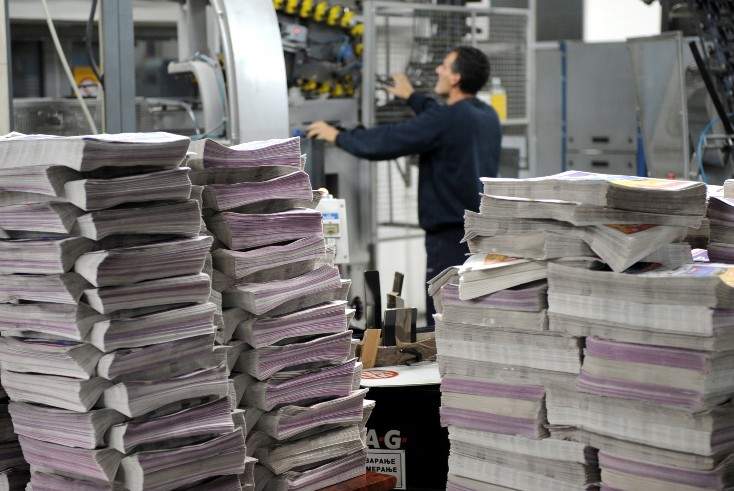News publishing will become more consolidated. Is it a good thing?

Opinion
As DMGT Media and News UK look to pool their printing operations, should we expect more consolidation among publishers and what it might look like in the digital age?
Sometimes it takes a big deal or major departure to crystallise a trend that has been happening gradually in plain sight, rather like the business equivalent of a slowing melting glacier.
My God. Has it really got that bad?
Yes indeed, it seems that the gradually melting away of paid-for newspaper print sales has resulted in radical action. Or will, if competition regulators allow.
Modern printing plants can still seem wondrous in their speed and efficiency even though such basic, necessary cogs in the publishing industry tend to be taken for granted.
The proposed joint printing venture between DMGT Media and News UK’s Newsprinters, which will pool and contract the printing operations of the two major publishers, looks like an urgent necessity.
As Enders Analysis has highlighted, the proposed joint venture is being driven by obvious mathematics – as the number of print copies of national newspapers in the UK fall, the unit cost of printing them increases, unless something is done.
With the total number of print copies down below 3 million a day, a fall of around 60 per cent in a decade, further consolidation becomes inevitable.
The final phase
At the moment there are three fully dedicated national newspaper printing operations – Reach, which publishes the Mirror, People, Express and Star and DMG Media for the Mail and Newsprinters for The Times and The Sun.
Alas for printing jobs, two major print sites Thurrock and Dinnington, both of them currently operated by DMG Media, have been marked for potential closure.
The move is being seen, in a rather gloomy way, as the industry entering the final phase of industrial scale national newspaper printing.
As Enders’ lead newspaper analyst Douglas McCabe puts it, the aim of proposed joint venture is “to extend that final phase of industrial scale printing for as long as possible.”
As everyone knows, the cruel irony is that in general it is print that usually produces not just greater impact than online but also higher revenues and profits.
It remains a curious, almost unfortunate business model, that depends so heavily on a wasting asset despite the superficial attraction of an apparent endless universe of numbers on the internet.
You don’t have to own your own printing press to deliver printed copies of national newspapers as the Financial Times, The Daily Telegraph and The Guardian demonstrate daily.
Perhaps further printing consolidation will become inevitable – with printing becoming more of a neutral facility, as long as the necessary geographical spread is maintained.
The writing is already on the wall, with Enders projecting that printed news circulation will fall below 2 million a day by 2028.
CMA can’t miss the big picture
Will the Competition and Market Authority (CMA) allow such a contraction of competition in printing, given that overall, most news groups are decently profitable?
The CMA, and its predecessors, have form in the media marketplace. They have been happy to block small but necessary mergers in local commercial radio and the regional press, thereby missing the big picture.
Instead they have gone for perfect competition, and notoriously in the case of television, blocked co-operation because of the danger that businesses that did not even exist might somehow be harmed in future.
Hopefully the CMA will now demonstrate it has a sense of history and will not repeat the mistakes of the past.
In this case, the big picture is that the production of original, accurate, reliable journalism is a very expensive business and for it to survive, certainly in its printed form, every part of a complex machine has to be working to the maximum feasible efficiency.
That argues certainly for more consolidation in the publishing industry, certainly in printing and probably also in distribution, which again can operate as a neutral process. Distribution is a case where competition can mask expensive duplication.
Further consolidation of titles is far from ideal but may also become an economic necessity further down the line.
Reach appears to be able to operate under the same corporate roof such different titles politically as the Labour-supporting Mirror and the embarrassingly Conservative Daily Express.
The main problem with the Express, with its mindless support for Brexit and every Tory leader — however incompetent or untruthful — laced with bogus polls, is how badly it does its job. The model could work better but that that is another story.
A number of publishers are already collaborating with Ozone, the online premium advertising platform, a development that, according to Enders “is welcomed and trusted by advertisers.”
Publishers need to differentiate themselves from the noise
They will have to go much further as the world of generative AI threatens to create a whole new world of nonsense all around us.
Fictitious comments by Labour leader Sir Keir Starmer and false claims that Israel was about to let off a nuclear weapon in the Gaza strip is only the beginning of it.
The established brands, with print as long as it can be economically produced, have to find a way of differentiating themselves from all the purveyors of false online information, however it is produced. And greater co-operation has to be part of the solution.
The UK’s public service broadcasters have already offered a template. Next year they will launch Freely, a joint streaming service aimed at broadband which will also carry on-demand material.
This may be a bit late, largely because of the activities of the competition authorities, but at least it is about to happen.
Something similar needs to come from news providers if they are going to avoid what they produce becoming a smaller and smaller proportion of the ever-expanding online universe that bring with it the bogus and malignant.
It has been suggested that the online output of established publishers should have a form of “watermark” to protect against counterfeiters.
But something more ambitious is surely necessary – the creation of a joint website where curated, regulated, and trusted journalism can come together with a mixture of free and subscription content.
It may be wise to outsource printing and distribution, but maybe publishers should start wondering whether it is wise to outsource their journalistic future to Google and TikTok.
Some of the cost of exploring such future possibilities can come from the money saved from consolidating printing plants.
 Raymond Snoddy is a media consultant, national newspaper columnist and former presenter of NewsWatch on BBC News. He writes for The Media Leader on Wednesdays — read his column here.
Raymond Snoddy is a media consultant, national newspaper columnist and former presenter of NewsWatch on BBC News. He writes for The Media Leader on Wednesdays — read his column here.




